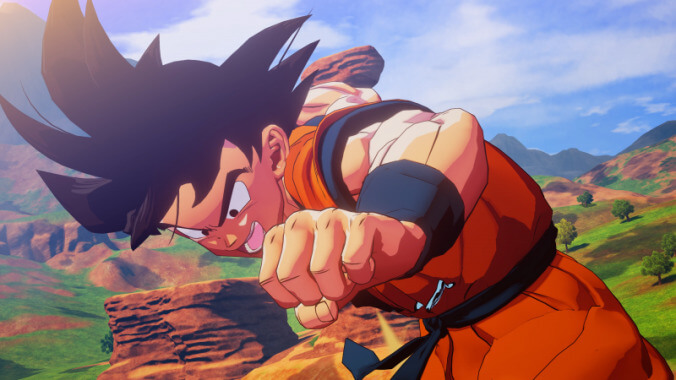The new Dragon Ball Z game is a pitch-perfect recreation of a godawful kids’ cartoon


Every Friday, A.V. Club staffers kick off our weekly open thread for the discussion of gaming plans and recent gaming glories, but of course, the real action is down in the comments, where we invite you to answer our eternal question: What Are You Playing This Weekend?
When the forces of Sports Game Nerd and Anime Fighting Game Nerd finally come together in some dark and distant future, it’ll be one topic that unites them: the grim, cash-draining specter of the annual release. The sports folk, of course, are well acquainted with the yearly stream of Madden games churning down the line toward them, each with the mark of the coming year emblazoned upon their brow. But it’s not like the anime people are all that far behind. To put it another way, did you know there have been nearly 50 damn Dragon Ball games that have come out since the franchise debuted in 1984?
That’s, to use a technical term, a shit-ton of Goku, which is also how we find ourselves forced to describe the franchise’s latest installment, Dragon Ball Z: Kakarot, which came out last week. It’s not that the game, from studio CyberConnect2, is bad, precisely. The battles, which see you zip around the countryside blasting your enemies with ki blasts and hastily shouted attack names, are cinematic, quick-paced, and only occasionally horrifically buggy. (Punching an enemy fighter through a mountain is cool; punching him down into the terrain, then watching him glitch out until the game gives up and resets his position, is not.) The visuals are gorgeous, coming closer than anything yet seen to recreating a perfect 3D version of the animated show. The open world elements, which see you flying around the landscape, solving minor quests, collecting stuff, and just generally chillin’ with Krillin, are not, in of themselves, an automatically awful idea. And the little community boards you plug character emblems into to unlock new powers are even fun, in a compulsive, I-used-to-spend-hours-assembling-the-demon-map-in-Shadow-Hearts-2 kind of way.
It’s just that all of this is in service of telling the story of, well, Dragon Ball Z. Again. For something like the, what, 20th time in the medium of games? And honestly, if there’s a record for the most times a more boring story has been told with such undue reverence, the only thing that’s going to give it a run for its money are the snoozier bits of The Bible. Almost every Dragon Ball game plods its way through the beats of the original anime series in some way or another, but Kakarot is more faithful than most, walking you through every single step of each of the show’s four major chapters. That means being faithful to stilted, repetitive dialogue (lovingly recreated by many of the series’ old voice actors, natch). It’s being faithful to old men waving their horny flag far higher than anyone is comfortable with in 2020. Faithful to a whole host of deeply irritating characters who exist only to service an idea of funny that’s now multiple decades in the rearview. And, most especially, faithful to the show’s bizarre dedication to filler.
As anyone who actually watched Dragon Ball Z during their childhood—waiting with bated breath for Funimation to ship more episodes of the Frieza saga Toonami’s way—knows, the series never said in one episode what it could just as easily say in five. And thus, too, goes Kakarot, which stretches out every battle, every meandering conversation, and every stage of transformation and “powering up” into its own separate step, battle, or cut scene along the way. The endless back-and-forth of “I’m more powerful!” “Well, now I’m more powerful!” “Well now I’m infinity more powerful!” felt borderline tiresome even in the eyes of 12-year-old viewers; you can be damn sure it feels even worse as an adult, and with a hefty set of loading screens tacked on, to boot.
It’s not like there’s not some nostalgic appeal at play. There’s an elemental, little kid part of the human brain that’s never not going to freak out a little at watching Goku go Super Saiyan for the first time, or that doesn’t thrill at his kid Gohan’s faltering steps along the hero’s journey. Even seeing multiple fights get lavished on also-rans like Zarbon and Captain Ginyu twinges some little “I remember that!” synapse. It’s just that there are other stories out there, you know? It’s not for nothing that the most interesting Z game in more than a decade, 2018’s Dragon Ball FighterZ, is the one that opted to tell an original plot. (It also dials the series down to its buff-people-punching-each-other basics, which didn’t hurt.) Even for its faults, Dragon Ball Z: Kakarot is an amazing technical and visual achievement; it’s just not clear how many more times we can undergo the Stations Of The Goku before the last traces of lingering affection for this series are well and truly lost.